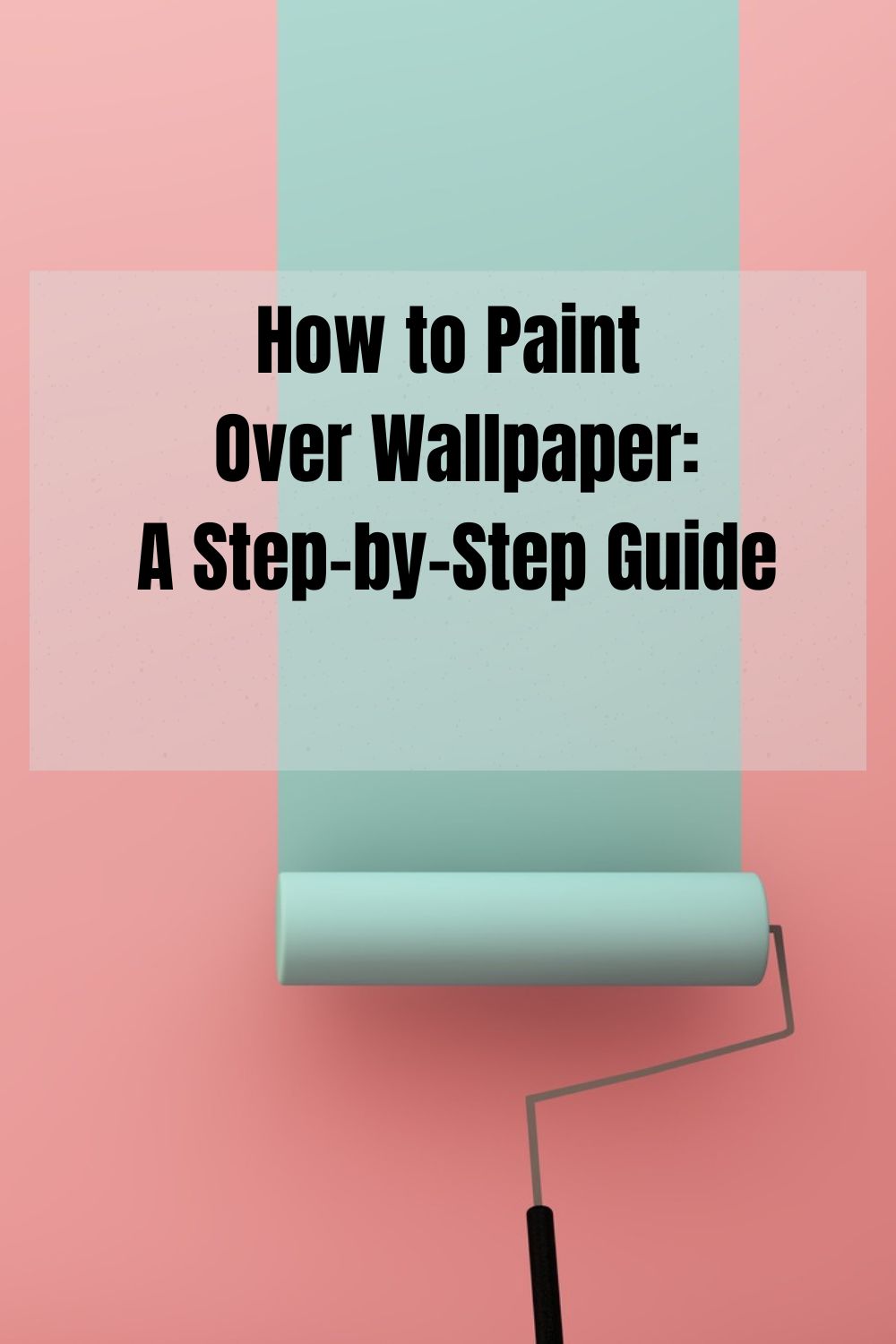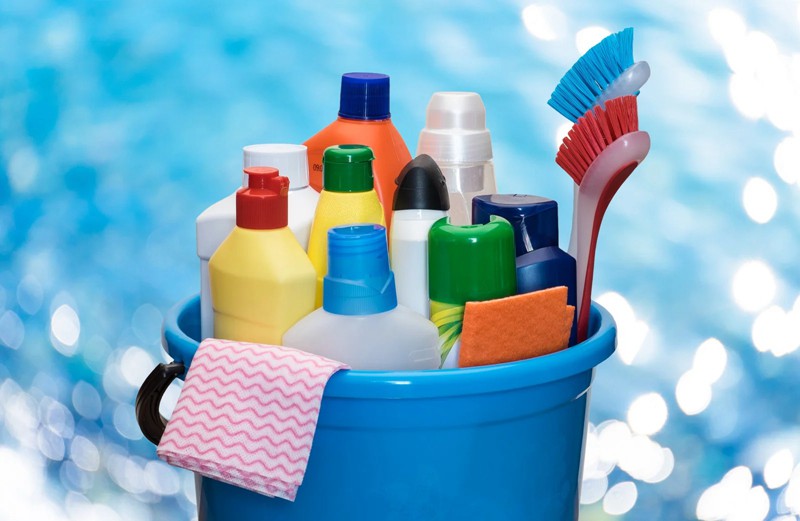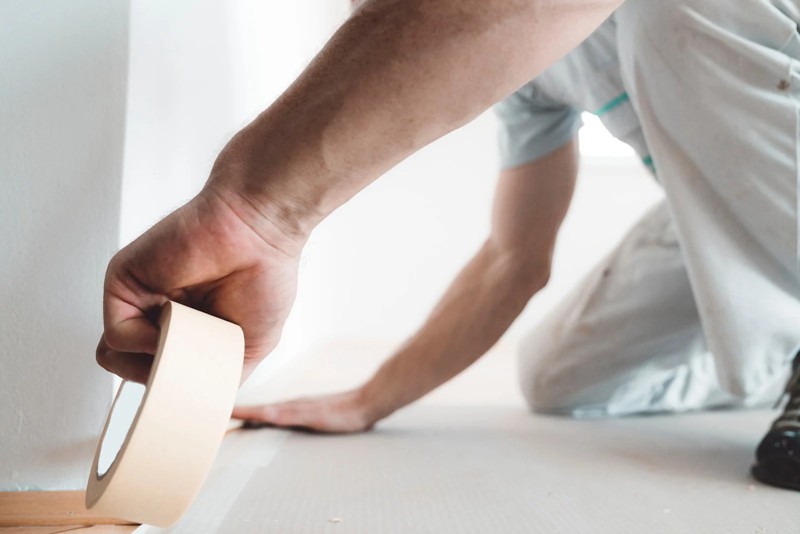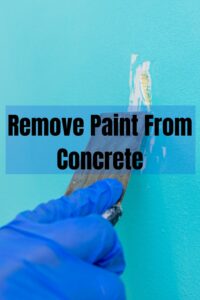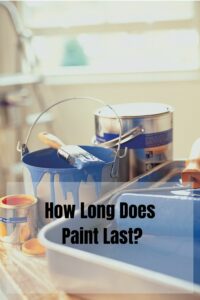Is there any outdated wallpaper on your walls that just doesn’t look right? Are you unable to fix it because you lack the time and energy? Or are you hesitant to remove it to protect your wall from damage? Then you want to know how to paint over wallpaper or if it can even be done at all.
Painting over a wallpaper may not always be the best option when looking for a change. Professionals and painting experts advise against it, stating that removing it is preferable.
However, in some cases, this is not the case. If the wallpaper firmly adheres to the surface, it will be difficult to remove without damaging the wall.
You don’t need to worry if you want to paint over your wallpaper but are unsure how to do it. This article will walk you through the steps of painting over wallpaper to achieve a stunning result.
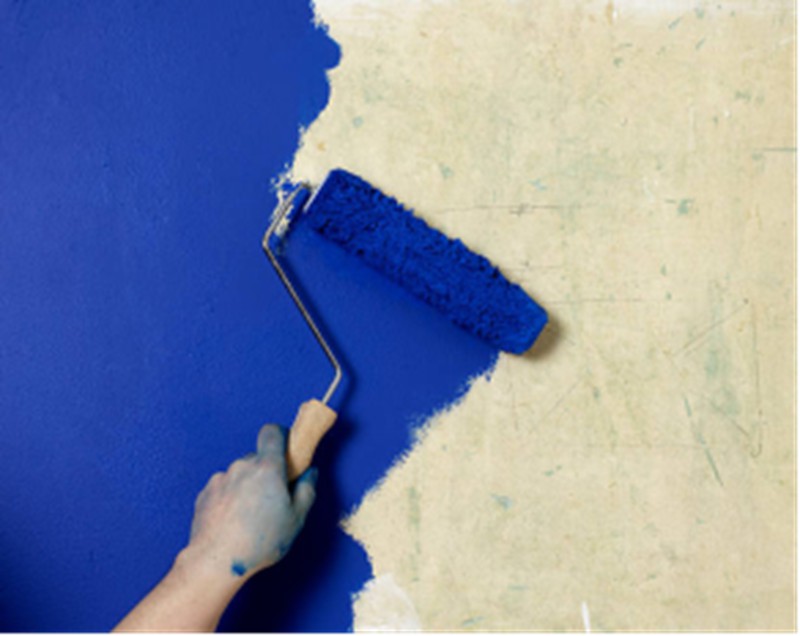
Table of Contents
When is it Inappropriate to Paint Over Wallpaper?
In the work of home improvement, painting over wallpaper is not advised. The widely accepted solution is to remove the wallpaper and paint the blank wall. You are not limiting yourself in this way. Moreover, not all wallpapers can be painted over.
In what situations should wallpaper not be painted over?
- There is mold and numerous tears on the wallpaper. You cannot paint over mold without addressing what is causing it because the paint will only cover it up and worsen it over time.
- Paint should not be used on fabric wallpaper. Paint and primer can easily seep into it because of its porousness. Layers and layers of paint will need to be applied, leaving behind a disorganized appearance. It is not impossible to paint, though.
- Unless you only intend to change the color, try removing any wallpaper with a pattern because it will show through the paint. It will take as much time as removing it because you will have to sand it until the surface is completely smooth.
- It is preferable to remove the wallpaper if you intend to stay in this home for a longer period so that you are not constrained by it when working on future home renovations.
When Should You Paint Over Wallpaper?
If the wallpaper is still intact and adhered to the wall, you can paint over it. By carefully following the instructions in this guide and employing the proper equipment, you can successfully paint over your wallpaper.
So, when should you paint over the wallpaper?
- When the wallpaper is difficult to remove and may damage the wall behind it. It is preferable to paint over the wallpaper because it would ruin the wall if it were not primed before being attached.
- If you are short on time and need a quick solution to your decorative problem.
- This is a good option if you are on a budget but still want to improve your home.
Tools You Need to Paint Over Wallpaper
You will need these supplies and tools to paint over your wallpaper. Remember to buy high-quality painting tools.
- Old clothes that cover you up
- Safety goggles, nose mask, and rubber gloves.
- Drop clothing for your floor and furniture.
- Painter’s tape to section off the painting area.
- Cleaning rags and sponges for cleaning the wallpaper
- Sugar soap/detergent/trisodium phosphate as a cleaning agent.
- Wallpaper glue for peeling or loose seams.
- 120-180 grit sander/sandpaper to smoothen the wallpaper and remove air bubbles.
- Putty or utility knife (convenient for a painting project)
- Spackle for holes and spots that need to be filled
- Paint brushes and rollers
- Oil-based or shellac-based primers.
- Paint
How to Paint Over Wallpaper (Step-by-step Guide)
If you want to paint over wallpaper, you might as well be equipped with the proper knowledge of how to do it. Here’s a guide you can follow.
Step 1: Clean the Wallpaper
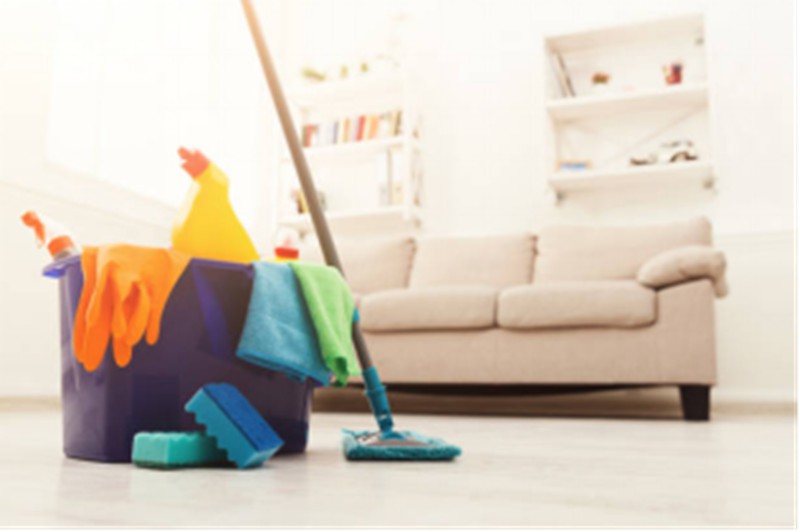
Before starting any painting project, you must ensure the surface you want to paint is clean. Many things on the surface (detectable and undetectable) can act as obstructions to your paint. You do not want grease, dust, sand, or dirt on your wallpaper.
If you do not clean your wallpaper before you begin, the primer will not adhere properly.
If the primer doesn’t stick to the wallpaper, the paint will also not stick.
Another reason to keep your wallpaper clean is that any dirt or grease on it will show through the paint, which is unappealing.
There are several methods for cleaning wallpaper. You could use the chemical trisodium phosphate (TSP), damp cloth and soap, wallpaper dough, or vacuuming.
Protect Yourself
To clean the wallpaper, open the doors and windows to let fresh air in, especially when you use chemicals to do the cleaning.
Put on some old clothes, an eye protector or safety goggles, gloves, and a mask or ventilator to protect yourself from the effects of direct contact with harmful chemicals.
Vacuuming or Dusting
Remove surface dust, cobwebs, and debris with a vacuum, broom, and cloth before washing the wallpaper. Attach a brush to the telescopic arm of the vacuum and use a gentle sweeping motion to remove any dust from the wallpaper.
Cleaning with Trisodium Phosphate (TSP)
This cleaning agent prepares the wallpaper for painting by effectively removing chemicals and unwanted oils. To use TSP, combine a half cup with two gallons of water, then wipe down the wallpaper with a paintbrush.
Allow TSP to dry before proceeding. When dry, wipe it away with a damp rag. You can purchase TSP from a hardware or paint store.
Cleaning With Soap
For coated wallpaper, mix a bit of clear detergent in water and use a sponge to wipe it from top to bottom gently. Then, rinse strip by strip with a fresh cloth and clean water.
Avoid using horizontal motion so you don’t pull at the seams. Change the water and sponge at intervals so you’re not spreading dirt.
To be safe, perform a patch test in an unnoticeable spot. This helps you practice how much water to use on the sponge. You can only use water to wash nonwoven and metallic or vinyl wallpapers. After washing, allow it to dry for up to 24 hours.
Tip: To avoid damage to the wallpaper if water sips into its seams, use a damp rag that is not dripping with water or soaking. Water can loosen the wallpaper even more and cause bubbles beneath it.
Step 2: Repair Damages to the Wallpape
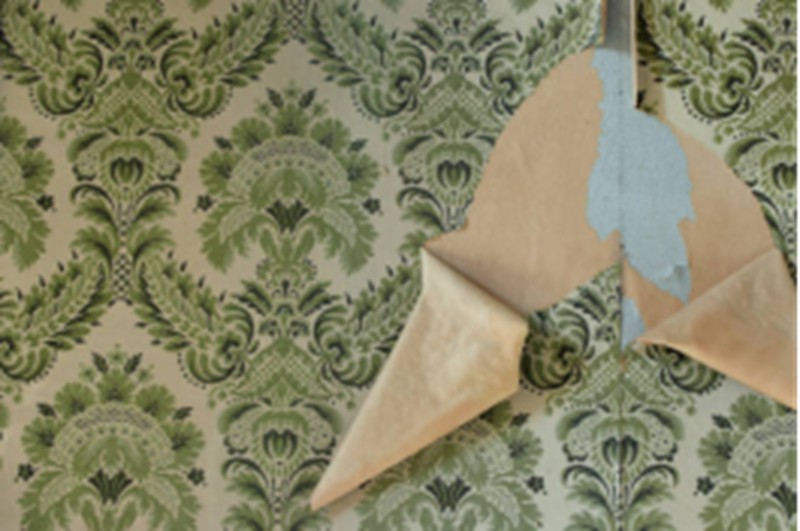
When the wallpaper is old and has damaged spots, you need to repair it before painting over it. You need a smooth surface for the primer and paint to adhere to the wallpaper, and if you want a flawless result, you do not want any hole or tear to remain.
Check and Repair the Seams
Inspect the edges of the seams at the top and bottom to see if the wallpaper is loose at those points.
Seams are typically the weakest adhesion points, so they are the first to separate from the wall. You don’t want to see loose seams through the paint because they can be the source of paint break.
One solution is to use a thin adhesive to glue the loose edges together. Another option is to cut the fraying bits with a putty knife, then fill the joint compound with spackle if the wallpaper overlaps in some places.
Check the Body of the Wallpaper
Inspect the body of the wallpaper for screw holes, cracks, bubbles, and tears. Use spackle to fill them when you find any. Paint will only highlight these imperfections if they are left unaddressed.
Sand Down Wallpaper
After the spackle is dry in all the areas of application, sand down for a smooth and level surface. Use a 120-180 grit sander over the edges and the body of the wallpaper. After sanding, use a slightly damp rag to remove any residual dust from the surface.
Step 3: Tape Up the Work Area
If you want to paint only the wallpaper, use painter’s tape to section it from the adjoining surfaces when painting the wallpaper and to keep the paint from staining other surfaces.
Tape along the ceiling, baseboards, molding, window frames, door frames, switches, and sockets.
Overlap each section of tape and press down with a knife to ensure it adheres firmly. Primer and paint will not easily seep through the wallpaper edges when you use tape.
Step 4: Prime the Wallpaper
To prime your wallpaper, you’ll need an oil- or shellac-based primer to act as a barrier between the wallpaper and the paint. Latex- or water-based primer will wet the wallpaper, causing it to lose adhesion to the wall, whereas the oil-based primer will sit on top of it.
Oil-based primers are helpful when the color of the wallpaper is darker than the color of the paint. We recommend using a gray-tinted or stain-blocking primer to prevent the color from showing through the paint.
Apply the primer as you would paint. Cut in with an angled paint brush, and roll it on the wallpaper surface, covering everything in it. The one coating should suffice unless directed otherwise.
Allow the primer to dry completely before lightly sanding the wallpaper with a 120-180 grit sander. Then clean it with a damp rag.
Safety Tip: Working with an oil-based primer can expose you to volatile organic compounds (VOCs), so ensure the room is well-ventilated.
Step 5: Paint the Wallpaper
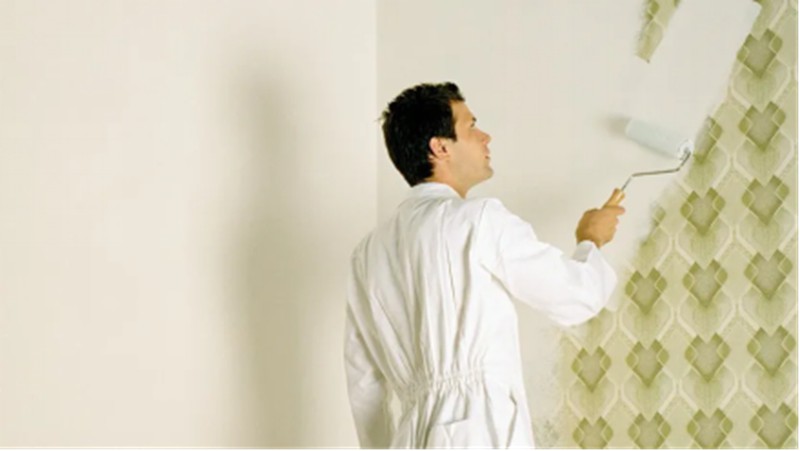
After the primer has dried (you can let it cure overnight for a better result), you will paint the wallpaper in the same manner as you did the primer. It is, however, acceptable to use latex-based paint at this time. If this is your first time painting, here’s a quick rundown:
Begin by cutting into the wallpaper’s edges with a small, angled paintbrush or a mini roller. This is where you target areas that can be difficult to reach or connect to areas you don’t want to paint, such as tight corners, windows, door frames, baseboards, the ceiling, etc.
Roll on paint in a big “M” shape with a roller. Continue to roll the paint from top to bottom, leaving the edges free so you can overlap another line.
Repeat until you have painted the entire wall. Then allow this first coat to dry. You should apply a second coat after the first is completely dry for the best results.
Step 6: Finish Up
Inspect your work thoroughly to see if there are any dark or rough spots. You can apply an additional layer of paint. Remove the painter’s tape at a 45-degree angle. Clean your space and rearrange it to your liking. Now, you’re done!
Frequently Asked Questions
How Can I Protect My Wallpaper?
You can protect your wallpaper by applying decorator varnish to it. This will make it more resistant to stains, marks, and indentations.
How Can I Tell if My Wallpaper is Washable?
You can have a professional look at it or test a section with water to see if it absorbs water. If it does, it is fabric-based; if not, it is nonwoven.
Is it Cheaper to Paint on Wallpaper?
Wallpaper is the cheaper option, and it lasts relatively longer than paint. However, in the short term, paint is more affordable.
Final Words
Painting over a wallpaper may not be as popular as removing the wallpaper. It can, however, be done and, in some cases, is a better option. If you carefully follow the steps, you will achieve satisfying results. Please leave your questions and comments below; we will gladly assist you.

